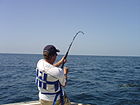Bottom fishing
Bottom fishing, also called legering in the
Gears
A common
Specialized fishing rods called bottom rods or "donkas" are also commonly used for bottom fishing. Due to the lack of a float to relay underwater status to the surface, a quiver tip (often coupled with a jingle bell) is used to signal the fisherman about whether the fish has successfully taken the hook.
The objective for rigs used for bottom fishing is to take your bait to the bottom of the water and lure in the fish. The bait must appear appetizing to the fish. The most common rig used in bottom fishing is called a "fish finder rig". The next rig is called a "porgy rig" for the reason that it is effective on
Other meaning
In stock market terminology, bottom fishing can mean buying the cheapest investments (in terms of valuation ratios) available. Bottom fishing is value investing concentrated on the very cheapest companies. The term can be derogatory as it can imply a lack of attention to the quality of the investments selected.
In
See also
Notes
- ^ Charlie. "Basic Bottom Fishing". Southern Chain Sport Fishing. Retrieved 10 July 2012.
References
- Keyes, Michael J (1992) Modern Bank Fishing: How to Leger - Bottom Fishing Techniques for Carp E a S Publications. ISBN 978-0-9634051-0-4



